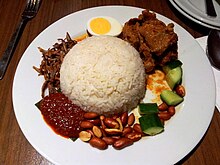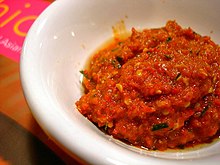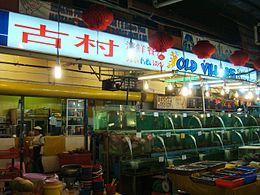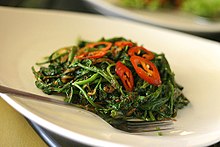
Malaysian cuisine consists of cooking traditions and practices found in Malaysia, and reflects the multiethnic makeup of its population.[1]The vast majority of Malaysia's population can roughly be divided among three major ethnic groups: Malays, Chinese and Indians. The remainder consists of the indigenous peoples of Sabah and Sarawak in East Malaysia, the Orang Asli of Peninsular Malaysia, the Peranakanand Eurasian creole communities, as well as a significant number of foreign workers and expatriates.
As a result of historical migrations, colonisation by foreign powers, and its geographical position within its wider home region, Malaysia's culinary style in the present day is primarily a melange of traditions from its Malay, Chinese, Indian, Indonesian and ethnic Bornean citizens, with heavy to light influences from Thai, Portuguese, Dutch, and British cuisines, to name a few. This resulted in a symphony of flavours, making Malaysian cuisine highly complex and diverse.
Because Peninsular Malaysia shares a common history with Singapore, it is common to find versions of the same dish across both sides of the border regardless of place of origin, such as laksa and chicken rice. Also because of their proximity, historic migrations and close ethnic and cultural kinship, Malaysia shares culinary ties with Indonesia,[2] as both nations often share certain dishes, such as satay, rendang and sambal.
Food and ingredients
Pantry essentials
Chilli peppers are indispensable to Malaysian kitchens, and both fresh and dried chilies are used. Chillies come in several sizes, shapes and even colours. As a general rule, two type of chilli cultivars are the most commonly available: the bird's eye chili (cili padi), which although small in size are extremely pungent and very hot; and longer varieties, which tend to be much milder. Green chillies are more peppery in taste, while red chillies, green chillies which have been left to ripen, have a slightly sweeter heat. If a milder flavour is preferred, the seeds and membranes are removed from the chili pods before they are cut, or the chillies are left whole and removed prior to serving. Some common uses include but are not limited to: grinding the chillies into a paste or sambal; chopping fresh chillies as a condiment or garnish; and pickling whole or cut chillies.
Belacan is essential to Malaysian cooking. It is a type of shrimp paste which is pressed into a block and sun-dried. In its raw form it has a very pungent smell. Once cooked, the shrimp paste's aroma and flavour mellows and contributes a depth of flavour to the dish. To prepare belacan for use, one typically wraps a small amount in foil, which is then roasted over a flame or placed into a preheated oven. Belacan is most commonly pounded or blended with local chilli peppers, shallots and lime juice to make the most popular and ubiquitous relish in Malaysia, sambal belacan. Belacan is also crumbled into a ground spice paste called rempah, which usually includes garlic, ginger, onions or shallots, and fresh or dried chilli peppers. A rempah paste is similar in form and function to an Indian wet masala paste or Thai curry paste, and is often browned and caramelised (Malay: tumis) to mellow the raw flavours of its component ingredients and produce a harmonised finish.
The coconut (Malay: kelapa) is another quintessential feature of Malaysian cuisine, and virtually all parts of the plant are used for culinary purposes. The white fleshy part of the coconut endosperm may be grated, shredded and used as is; dried to make desiccated coconut; or toasted until dark brown and ground to make kerisik. Grated coconut flesh is also squeezed to make coconut milk, which is used extensively in savoury dishes and desserts throughout the country. Coconut oil is used for cooking and cosmetic purposes, and may be either obtained by processing copra (dried coconut flesh) or extracted from fresh coconuts as virgin coconut oil. Coconut water, the clear liquid found inside the cavity of each coconut, is a popular cooler in Malaysia's hot and humid climate. Gula melaka is unrefined palm sugar produced from the sap of the coconut flower. It is the most traditional sweetener in Malaysian cooking and imbues a rich caramel-like flavour with a hint of coconut. Coconut fronds are traditionally used to wrap food, hollowed out coconut husks and shells may be used as a source of charcoal fuel for barbecued meats and traditional pastry making, and even the apical bud or growing tip of the coconut palm is a popular delicacy served in rural communities and specialist restaurants.
Soy sauce of different varieties is another important ingredient. Light soy sauce contributes its pleasantly salty flavour to a variety of stir-fries, marinades and steamed dishes. In some hawker establishments, freshly sliced or pickled chillies arrive immersed in light soy sauce to be used for dipping. Dark soy sauce is thicker, more intense in flavour and less salty. It is often used when a heartier flavour is desired, particularly with masak kicap (a style of braising with a blend of soy sauce varieties) dishes, and also to darken the color of a dish. Kicap manis, sweetened soy sauce sometimes flavoured with star anise or garlic, is also a popular seasoning for cooking. The sweet and savoury taste of kicap manis also functions as a substitute to approximate the combination of dark soy sauce and thick caramel sauce, which is primarily used to colour and season stewed dishes.
Common herbs include lemongrass (Malay: serai), a type of grass with a lemony aroma and flavour. Young, fresh stems are more desirable as older stems tend to acquire a woody texture: the tender white part closest to the base of the stem is thinly sliced and eaten raw in salads, or pounded with other aromatics to make a rempah. It is also used whole in boiled and simmered dishes. The pandan (screwpine) leaf is the Asian equivalent of vanilla in Western cuisine. The subtle aroma is released when the leaves are bruised by tying one or two long leaves into a knot, and used for cooking curries, rice and desserts. The leaves can also be used to wrap items like rice, chicken or fish for cooking. Pandan leaf is also available in liquid essence or powdered form to flavour and colour cakes. Turmeric (Malay: kunyit) is a rhizome popular for its flavour as well as colouring properties. The leaves and flowers of the turmeric plant are also used in cooking or eaten raw.
Tofu products, specifically fried tofu, are widely used as cooking ingredients and as side accompaniments. While fried tofu can be bland in flavour on their own, its main contribution is texture and especially with tofu puffs, the ability to soak up the flavour of whatever they are cooked in. Fried tofu products are found as a versatile component ingredient for dishes like stir fried noodles, rojak (fruit and vegetable salad), noodle soups, and stews. A popular way of serving fried tofu on its own is a salad with bean sprouts, shredded cucumber and spring onions, covered in a thick sweet and spicy dressing and dusted with roasted ground peanuts. Fried tofu may also be stuffed with a mixture of ground meat or shredded vegetables.
Dried seafood products contribute a savoury depth of flavour to some Malaysian dishes. Small dried anchovies, known as ikan bilis, are very popular. It acquires a very crispy texture when deep-fried, and is served as an accompaniments or prepared as a sambal relish in this capacity. Ikan bilis is also boiled to make fish stock; in fact, instant ikan bilis stock granules are a popular seasoning in modern kitchens. Dried shrimp and salted dried fish are also used in various ways.
Other essential seasoning and garnishes include tamarind (Malay: asam jawa), specifically the paste-like pulp extracted from the fruit pod which contributes a tart flavour to many dishes. Candlenuts (Malay: buah keras) are similar in appearance to macadamia nuts, being round, cream coloured and have a high oil content. Candlenuts are normally ground to thicken sauces. Lup cheong is a type of dried Chinese sausage made from pork meat and spices. Mainly used by the Malaysian Chinese community, these sweet sausages are usually sliced very thinly and added for additional flavour and texture. Recent studied have shown that there are 62 commonly consumed Malaysian foods that include biogenic amines.
Rice
Rice (Malay: nasi) was and still is the most important staple food in Malaysia. According to Indonesian-born food and cookery writer Sri Owen, there is some evidence for rice cultivation found in the state of Sarawak in Malaysian Borneo dated 2300 BC, and about 900 years of history for the state of Kelantan in West Malaysia. Today Malaysia produces about seventy percent of the amount of rice it needs to support itself, and the rest is imported.[3] This is a matter of policy as the government believes that national resources can be used more profitably instead of attempting to achieve self-sufficiency with rice production; the prevalent attitude is that revenue generated from its industries enables the country to import up to half the rice it needs.[4] Nevertheless, the government is fully committed and involved in planning, allocating resources and managing subsidies for the rice farming industry. The state of Kedah is considered the "rice bowl"[5][6] (Malay: jelapang padi) of the country, accounting for about half of Malaysia's total production of rice.
Plain steamed white rice, to be served with side dishes of meat or vegetables, is typically prepared with an electric rice cooker at home. Some households and food establishments prefer to cook rice on a stove top with the absorption method or the rapid-boil method. Compressed rice, called nasi himpit, is another method of preparing and cooking rice: the rice is wrapped with fronds or leaves and compressed into the form of a cylinder, which is then cooked by boiling. The rice would compress and merge during the cooking process. Compressed rice is usually eaten cold with some sort of gravy, although it may be served warm in a broth or soup. A notable variant of compressed rice prepared by the Bugiscommunity is burasak: rice is precooked with coconut milk before it is wrapped in banana leaves and steamed until fully cooked.
Besides the ubiquitous white rice, there are different types of locally grown and imported rice available in the market, and each type has a specific cooking method to bring out optimal results.[7] Glutinous rice (Malay: pulut) is one example: because of its low amylose and high amylopectin content which results in a sticky texture after cooking, glutinous rice is prepared with different measurements and techniques and is not a suitable substitute for normal rice or vice versa. It is typically used for making snacks and desserts, but glutinous rice is also prepared as a savoury staple by indigenous peoples like the Orang Asli as well as the Dayak people of Borneo. Lemang is glutinous rice roasted in a hollowed bamboo tube, and is prepared for festive occasions like Ari Gawai, Hari Raya Aidilfitri, and Hari Raya Aidiladha.[citation needed]
Nasi lemak
A popular dish based on rice in Malaysia is nasi lemak, rice steamed with coconut milk and pandan leaves to give it a rich fragrance. Of Malay origin, nasi lemak is frequently referred to as the national dish.[8] It is customarily served with ikan bilis or fried anchovies, peanuts, sliced cucumber, hard boiled eggs and sambal. Although it is often considered a breakfast dish, because of the versatility of nasi lemak in being able to be served in a variety of ways, it is commonly eaten at any time of the day. For a more substantial meal, nasi lemak may be served with fried chicken, curries, or a spicy meat stew called rendang.
Congee
Congee is a type of rice porridge or gruel popular among Malaysia's ethnic communities. It is eaten primarily as a breakfast food or late supper. It is also considered particularly suitable for the sick as a mild, easily digestible food.[9] Congee is called bubur in Malay; 粥 written in Chinese, pronounced as zhou in Mandarin Chinese and juk in Cantonese; and kanji (கஞ்சி) in Tamil. It may be served plain with little embellishment, or cooked with ingredients like fish slices, seafood, chicken, beef, pork, vegetables, and even spices. The importance and popularity of congee in the Malaysian diet is such that bubur ayam or chicken congee is a permanent fixture on the menu of Malaysian McDonald's restaurants.[10]
Noodles
Noodles are another popular staple, particularly in Malaysian Chinese cuisine, but used by other groups as well. Noodles such as bi hoon (米粉, Hokkien: bí-hún, Malay: bihun; rice vermicelli), kuay teow (粿條, Hokkien: kóe-tiâu) or ho fun (河粉, Cantonese: ho4 fan2; flat rice noodles), mee (麵 or 面, Hokkien: mī, Malay: mi; yellow noodles), mee suah (麵線 or 面线, Hokkien: mī-sòaⁿ; wheat vermicelli), yee meen (伊麵 or 伊面, Cantonese: ji1 min6; golden wheat noodles), dongfen(冬粉, Hokkien: tang-hún, Cantonese: dung1 fan2; cellophane noodles), Lao Shu Fen (老鼠粉, Cantonese: lou5 syu2 fan2; silver needle noodles), and others provide an alternative source of carbohydrate to a serving of rice that accompanies every meal. Stir-fried noodle dishes (Malay: mee goreng) are ubiquitous throughout Malaysia's cities, towns and villages, with numerous localized variants prepared by various ethnic communities according to their culinary traditions and preferences.
Bread
Malaysia does not produce wheat, and all supplies are imported from wheat-producing countries. Nevertheless, Western style white breadand Indian breads made with wheat flour like roti canai are fairly common foods in the modern Malaysian diet today. A very typical way of serving white bread in Malaysia is having it toasted and spread with kaya, a sweet spread made from a base of coconut milk, eggs and sugar. Reflecting the British colonial influence in Malaysia, kaya toast or roti bakar is a popular breakfast staple and afternoon tea snack. It is typically paired with a cup of local brewed coffee or tea, and soft-boiled eggs to be seasoned to taste by the diner with soy sauce & ground white pepper. Roti kahwin is a variation where butter is sandwiched along with a layer of kaya between slices of untoasted white bread.
Traditional wheat-based pleated steamed bao or pao (Chinese : 包) is a Chinese staple which has become tightly woven into Malaysia’s gastronomic fabric. Pao are found in restaurants doing brunch dim sum trade, as well as specialist Chinese kopitiam. Sweet fillings may include tausa, lotus seed paste, kaya, pandan, ground peanuts, and custard; savoury fillings may consist of delicious stewed char siu(Chinese : 叉燒), chicken or pork. Malay versions (pau) may be found in night markets (pasar malam) and they are always halal, with fillings of curried potato, chicken or beef. Some variants have a quail egg in the middle in addition to the curry.
Oven-baked bread buns are also available in specialist bakeries, kopitiam, and restaurants. One local speciality in particular - a bun with a buttery core and topped with a crispy and fragrant coffee pastry crust - has achieved iconic status in Malaysia, and franchises like Rotiboy and Pappa Roti which specialise in these coffee buns have successfully expanded abroad to multiple nations and spawned hundreds of outlets. However, the popular buns that remain a favourite among Malaysians are the buns that are filled with a deliciously sweet shredded coconut filling, kaya (coconut jam), pandan kaya (screwpine with coconut jam), sweet corn, chocolate, red bean paste and butter buns.
Meat
Malaysian poultry is handled according to Halal standards, to conform with the country's dominant and official religion, Islam.[11]Imported poultry is available at major hypermarkets, supermarkets and speciality stores especially in affluent areas where a significant expatriate community can be found.
Fish, both freshwater and sea, features prominently in the Malaysian diet. Most local fish is purchased soon after it is caught, while frozen fish is generally imported. Such fish, namely salmon and cod, are well received on the Malaysian table but are not found in Malaysian waters.[citation needed]
Many types of seafood are consumed in Malaysia, including shrimp or prawn, crab, squid, cuttlefish, clams, cockles, snails, sea cucumber and octopus. In general, members of all ethnic communities enjoy seafood, which is considered halal by Malaysian Muslims (according to Shafi’i fiqh), though some species of crabs are not considered Halal as they can live on both land and sea. Sea cucumbers are considered halal.[citation needed]
Beef is common in the Malaysian diet, though it is notable that the consumption of beef is proscribed by some followers of Hinduismand certain Chinese folk religious sects. Beef can be commonly found cooked in curries, stews, roasted, or eaten with noodles. Malays generally eat beef that is halal. Australian fresh beef which is prepared under supervision of the Government Supervised Muslim Slaughter System (AGSMS) is imported into Malaysia and that beef is halal.[12]
Malaysian Malays, who form about half of Malaysia's population, are Muslim and therefore do not consume pork since Islam forbids it. This does not prohibit others from producing and consuming pork products, and thus pork can be found in wet markets, supermarkets and hypermarkets, usually displayed with a non-halal disclaimer. Pork is consumed by the Chinese Communities, the Iban, the Kadazan, Murut, Lun Bawang / Lundayeh, the Orang Asli, and expatriates.[citation needed]
In Malaysia, the term "mutton" refers to goat meat; lamb, or the meat of a young sheep, is always imported from countries like Australia and New Zealand. In the past mutton was primarily associated with the cooking of the Malaysian Indian community, and was not as widely eaten due to health concerns as well as its perceived gamey flavour. Today, dishes like whole spit roast of mutton, mutton briyani and mutton soup are now a common sight at banquets and events. Today, the demand for mutton during the fasting month and Hari Raya period has now far exceeded that for Deepavali and Christmas combined.[13]
Vegetables
Locally grown vegetable produce is available year-round as Malaysia is a tropical country and does not have four seasons. During rainy seasons, vegetable yields may decrease (which may result in an increase on market price), but rarely if ever stop altogether. Imported produce has made inroads into the market in recent years, either to supplement local demand for essential ingredients like garlic and potatoes, or to supply produce which do not grow well in Malaysia's climate and soil conditions. A few regions in Malaysia, like Cameron Highlands and the foothills adjacent to Mount Kinabalu provide the appropriate mean temperatures and soil conditions for the cultivation of temperate produce like Camellia sinensis or tea.
Malaysian-grown greens, tubers and vegetables commonly found nationwide include but not limited to amaranth (bayam), bean sprouts (taugeh), brinjals (terung), bitter gourd(peria), bok choi (sawi), cabbage (kobis), choy sum, cucumber (timun), Chinese celery (daun sup), coriander (daun ketumbar), ginger (halia), green beans, kangkung, "lady's fingers"(bendi), leeks, lettuce, lotus root, maize (jagung), napa cabbage (kobis cina), sweet potatoes (ubi keledek), spring onions (daun bawang), Sauropus androgynus (cekur manis or sayur manis), pumpkin (labu), shiitake mushrooms (cendawan), stink beans (better known as petai), tapioca (ubi kayu), taro or yam (ubi keladi), tomatoes, yambean or turnip, turmeric (kunyit), and yardlong beans (kacang panjang).[14]
In some areas in Malaysia local produce is grown on a small scale, and many rural communities like the Peninsular Orang Asli and certain tribal peoples of Sarawak forage wild edible ferns or vegetables to supplement their diet. Diplazium esculentum, better known as pucuk paku pakis, is perhaps the most widely available fern and is found in eateries and restaurants throughout the nation. Stenochlaena palustris is another type of wild fern popularly used for food. Endemic to East Malaysia, it is called midin in Sarawak and is prized for its fiddleheads by locals and visitors. Stenochlaena palustris is known by the native peoples of Sabah as lemiding, lembiding or lombiding, where both the leaves and the fiddleheads of the plant are eaten. The young shoots of plants like bamboo and coconut are popularly harvested as food by communities outside urban areas.
A popular way to cook leafy vegetables like kangkung and sweet potato leaves is stir frying with a pungent sauce made from belacan (shrimp paste) and hot chilli peppers. Other vegetables popularly cooked this way include bean pods and fiddlehead ferns like paku pakis and midin. Vegetables like carrots, cucumbers, onions and yardlong beans are used to make a localised variety of pickle called acar. Vegetables and herbs are also popularly served undressed and often raw in some rural indigenous communities as ulam. An ulam spread may include items such as banana blossoms, cucumber, winged beans, pegaga leaves, petai, and yardlong beans, typically eaten with a pungent dipping sauce like sambal belacan.








No comments:
Post a Comment